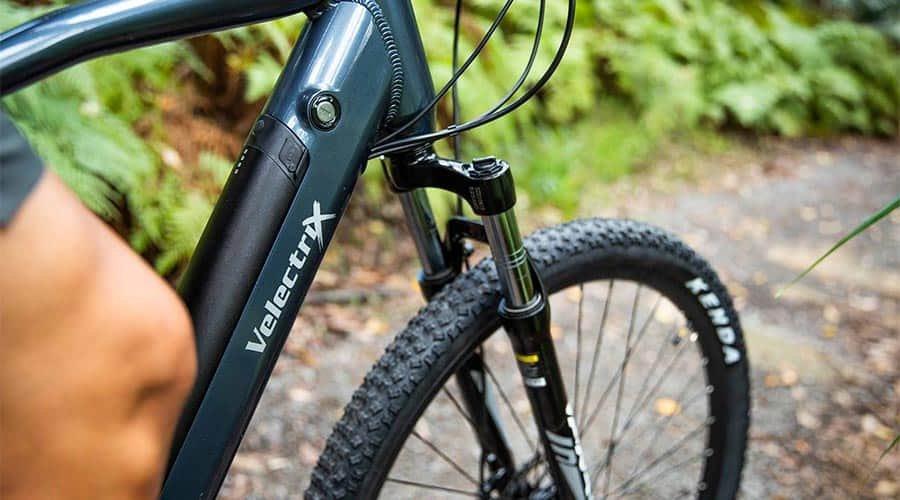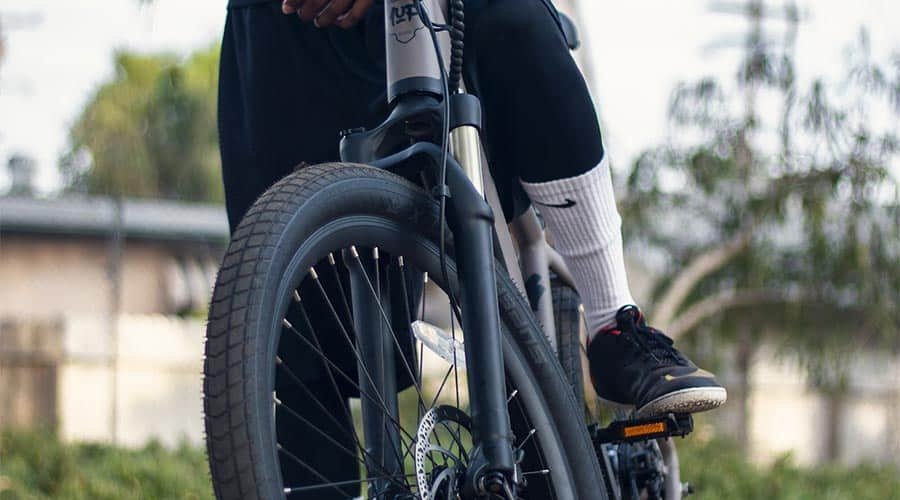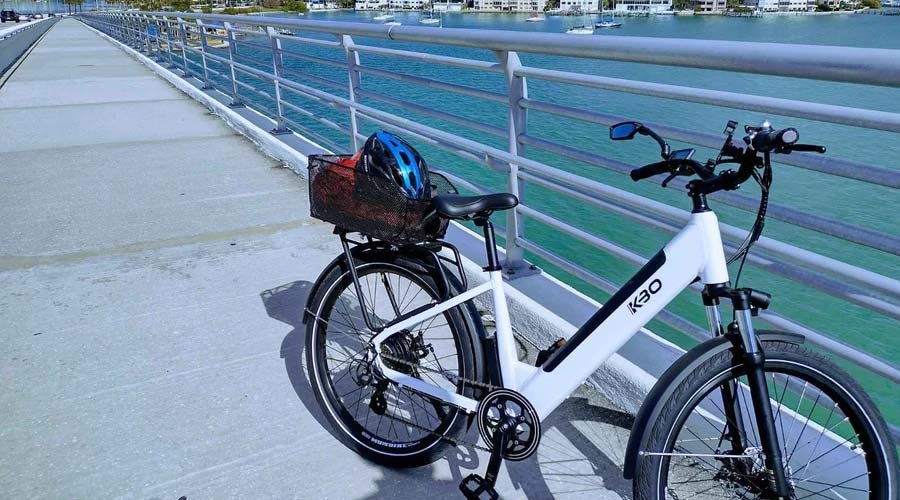One important factor to consider when choosing an ebike is the presence of suspension. Suspension, in the context of e-bikes, refers to a system of shock absorbers that help to dampen the impact of bumps and vibrations while riding.
In this article, we explore the world of ebike suspension and its impact on the overall riding experience. So buckle up and get ready to take a deep dive.
What Are Electric Bike Suspensions?

Electric bike suspensions are an important aspect of the e-bike design that can greatly impact ride comfort and performance.
These suspensions work by absorbing shocks and vibrations from the road, providing a smoother and more comfortable ride for the rider.
There are two main types of electric bike suspensions: front suspension and full suspension.
Front suspension, also known as a suspension fork, is typically found on most e-bikes and is located at the front of the bike.
This suspension system absorbs shocks from rough road surfaces and provides greater stability, control, and comfort.
Front suspension is particularly useful for riders who encounter rough terrain, such as cobblestone roads or bumpy bike trails.
Full suspension, on the other hand, features suspension on both the front and rear of the bike.
This type of suspension is often associated with a comfortable ride, as it provides a smooth and stable ride over even the most challenging terrain.
Full suspension is most commonly found on more advanced e-bikes designed for mountain biking or off-road use.
Overall, electric bike suspensions provide a crucial component of the e-bike design, offering riders a smoother, more comfortable ride over various terrains.
Whether you’re commuting to work or hitting the trails, a well-designed suspension system can greatly enhance your e-bike experience.
How Does E-Bike Suspension Work?

The suspension system of an e-bike serves the purpose of cushioning the rider from rough road conditions, ensuring a smoother and more comfortable ride experience.
By absorbing the shocks and vibrations from the road, the suspension helps to provide a more pleasant and relaxed ride.
The suspension system consists of a series of components, including:
◼️ Springs
◼️ Dampers
◼️ Forks
The springs on an e-bike suspension system act as a shock absorber, compressing and decompressing as the bike encounters bumps and rough terrain.
This helps to absorb the impact of the rough surface and reduce the amount of shock transferred to the rider.
The dampers, also known as shock absorbers, control the speed at which the springs compress and decompress.
They are responsible for controlling the amount of bounce and rebound, ensuring that the suspension works efficiently and effectively.
Finally, the forks, also known as suspension legs, are the main component of the suspension system. They connect the front wheel to the frame and hold the springs and dampers in place.
The forks on an e-bike suspension system are designed to be strong, lightweight, and durable, allowing them to withstand the demands of rough terrain and provide a smooth ride.
In summary, the suspension system on an e-bike works by absorbing shocks and vibrations from the road, providing a smoother and more comfortable ride.
Whether you’re riding on smooth roads or challenging terrain, a well-designed suspension system can greatly enhance your e-bike experience.
Do You Need Suspension On An Electric Bike?

The need for suspension on an electric bike depends on your intended use and personal preferences.
If you’re mainly using your e-bike for commuting or leisurely rides on paved roads and smooth surfaces, a basic front suspension system may be sufficient.
However, if you’re planning to tackle more challenging terrain, such as mountain biking or off-road riding, a full suspension system may be necessary.
While suspension is not a requirement on an electric bike, it can greatly enhance the ride quality and overall experience.
A well-designed suspension system can absorb shocks and vibrations from the road, reducing stress on the rider’s body and providing a smoother ride.
This is especially important for riders who suffer from back, neck, or joint pain, as the suspension can help reduce the impact of rough terrain on their bodies.
In addition to ride comfort, suspension can also improve the handling and stability of your e-bike.
By absorbing shocks from rough terrain, the suspension can help maintain the bike’s balance and stability, providing greater control and confidence for the rider.
Overall, whether you need suspension on an electric bike depends on your intended use and personal preferences.
For daily commuting or leisurely rides, a simple front suspension setup can provide a comfortable ride. But if you’re an adventurous soul, eager to conquer more challenging terrain, a full suspension system may be a better option.
What Are The Different Types Of Suspension In Ebike?

There are two main types of suspension in electric bikes: front suspension and full suspension- although there’s another type known as rear suspension.
Front Suspension
Front suspension, also known as a suspension fork, is typically found on most e-bikes and is located at the front of the bike.
This type of suspension system consists of a pair of tubes, or legs, that hold the front wheel in place and absorb shocks from rough road surfaces.
Front suspension is particularly useful for riders who encounter rough terrain, such as cobblestone roads or bumpy bike trails.
Full Suspension
Full suspension, on the other hand, features suspension on both the front and rear of the bike.
This type of suspension offers the best in terms of ride comfort, as it provides a smooth and stable ride over even the most challenging terrain.
Full suspension e-bikes have a suspension fork in the front and another shock absorber in the back, which work together to provide a smooth and stable ride.
Rear Suspension
In addition to these two main types of suspension, there are also various subtypes and variations of suspension systems, each designed to meet specific riding needs and preferences.
Rear suspension, for instance, is a common feature in electric bikes, as it helps to provide additional comfort and stability on rough terrain or off-road trails.
This type of suspension system typically consists of a shock absorber mounted near the rear axle of the bike. The shock absorber helps to absorb and dampen the impact of bumps and vibrations, resulting in a smoother and more comfortable ride.
Overall, the type of suspension in an e-bike depends on the intended use and personal preferences of the rider.
Whether you’re commuting to work or hitting the trails, there is an e-bike suspension system that is right for you.
Things to Look for When Shopping for an Electric Bike Suspension

When shopping for an electric bike suspension, there are several key factors to consider to ensure you get the best suspension system for your needs:
◼️ Travel: The travel of a suspension system refers to the amount of compression it can handle.
The more travel a suspension system has, the more it can absorb bumps and provide a smoother ride. Look for an e-bike suspension system with adequate travel for your riding needs.
◼️ Damping: Damping refers to the control of the speed of compression and rebound of the suspension system.
Look for a suspension system with adjustable damping, as this will allow you to fine-tune the system to your specific riding needs and preferences.
◼️ Adjustability: An adjustable suspension system can be fine-tuned to your riding style and the conditions you will be riding in.
Look for an e-bike suspension system with adjustable preload, rebound, and compression damping, as this will give you more control over the system and allow you to get the most out of it.
◼️ Weight: The weight of the suspension system is an important factor to consider, as it will affect the overall weight and handling of the bike.
Look for a suspension system that is lightweight yet durable, so you can enjoy the benefits of suspension without sacrificing performance.
◼️ Compatibility: Make sure the suspension system you choose is compatible with your e-bike’s frame, wheel size, and axle type.
Check the manufacturer’s specifications before purchasing a suspension system to ensure it will fit your bike properly.
◼️ Price: Suspension systems can range in price from affordable to high-end.
Consider your budget and your riding needs when choosing a suspension system, as more expensive systems may offer additional features and better performance.
When shopping for an electric bike suspension, consider the travel, damping, adjustability, weight, compatibility, and price of the system to ensure you get the best suspension system for your needs.
What Kind Of Suspension Is The Best For You?

The best type of suspension for you will depend on your specific riding needs and preferences. Here are a few factors to consider when determining the best suspension for you:
◼️ Riding terrain: For riders who mostly ride on smooth surfaces like paved roads or bike paths, a basic front suspension setup could suffice.
On the other hand, those venturing into rough terrains, like mountain biking or off-road riding, may require a full suspension system to ensure a comfortable and stable ride.
◼️ Budget: The cost of suspension systems can vary widely, from budget-friendly options to high-end setups. When selecting a suspension system, it’s crucial to consider your budget as the more expensive systems may provide extra features and enhanced performance.
◼️ Personal preferences: Consider your personal preferences, such as the type of ride you prefer (smooth and stable or responsive and agile), the level of adjustability you want, and the weight and style of the suspension system.
◼️ Rider weight and riding style: Your weight and riding style can also impact the type of suspension that is best for you.
Heavier riders may require a suspension system with more travel and adjustability, while more aggressive riders may prefer a system that is more responsive and agile.
Ultimately, the best suspension system for you will depend on your specific riding needs and preferences. It may be helpful to test-ride different e-bikes with different suspension systems to find the one that is the best fit for you.
In summary, when choosing the best suspension for you, consider your riding terrain, budget, personal preferences, rider weight, and riding style, and test ride different systems to find the best fit for you.
What Are The Advantages Of Suspension In An Ebike?
There are several advantages to having suspension on an electric bike, including:
🟩 Improved comfort: Suspension systems absorb the shock from rough terrain, providing a smoother and more comfortable ride. This can help reduce fatigue and make for a more enjoyable riding experience.
🟩 Increased control: Suspension systems can also improve the handling and control of an e-bike, allowing for better maneuverability and stability on rough terrain.
🟩 Reduced risk of injury: By absorbing shock from rough terrain, suspension systems can reduce the risk of injury to the rider, such as wrist and shoulder pain or strain.
🟩 Better traction: Suspension systems can also improve traction and grip, helping to maintain control on slippery or uneven surfaces.
🟩 Increased confidence: The improved comfort, control, and traction provided by suspension systems can increase the rider’s confidence and ability to tackle challenging terrain.
🟩 Enhanced performance: Suspension systems can also enhance the performance of an e-bike, improving its overall efficiency and effectiveness on rough terrain.
Overall, suspension systems can provide several benefits to electric bike riders, including improved comfort, control, and performance, reduced risk of injury, and increased confidence on challenging terrain.
What Are The Disadvantages Of Suspension In An Ebike?
While suspension systems offer many benefits, there are also some potential disadvantages to consider, including:
🟥 Increased weight: Suspension systems can add weight to an electric bike, making it heavier and less maneuverable.
🟥 Increased cost: Suspension systems can also add to the cost of an electric bike, making it more expensive than a similar bike without suspension.
🟥 Reduced efficiency: Suspension systems can also reduce the efficiency of an electric bike, as they require energy to operate and can result in increased energy consumption.
🟥 Maintenance: Suspension systems require regular maintenance, such as cleaning and lubrication, to keep them functioning properly.
🟥 Complexity: Suspension systems can also be complex and difficult to understand, requiring specialized knowledge and experience to repair or maintain.
🟥 Limited adjustability: Some suspension systems may not be adjustable, making it difficult to fine-tune the ride to the rider’s preferences.
Overall, suspension systems can have some potential disadvantages, including increased weight, cost, and reduced efficiency, as well as the need for regular maintenance and a level of complexity.
When considering a suspension system for an electric bike, it’s important to weigh the benefits against these potential drawbacks and make an informed decision based on your specific needs and preferences.
Can I Ride An E-Bike Without Suspension?

In most cases, you can ride an electric bike without suspension. In fact, many electric bikes are designed and sold without suspension, and many riders find that they don’t need it.
There are several factors to consider when deciding whether to ride an electric bike with or without suspension, including:
◼️ Riding terrain: If you’ll be riding primarily on smooth surfaces, such as paved roads or bike paths, you may not need suspension.
However, if you plan to tackle rough terrain, such as mountain biking or off-road riding, a suspension system may be necessary.
◼️ Budget: Suspension systems can add to the cost of an electric bike, so if you’re on a tight budget, a bike without suspension may be a more affordable option.
◼️ Personal preferences: Some riders may prefer the simplicity and low maintenance requirements of an electric bike without suspension, while others may prefer the improved comfort and control of a bike with suspension.
◼️ Rider weight and riding style: Your weight and riding style can also impact the decision to ride with or without suspension.
Heavier riders may find that suspension provides a more comfortable ride, while more aggressive riders may prefer the responsive and agile ride of a bike without suspension.
In conclusion, you can ride an electric bike without suspension, and whether or not you need suspension will depend on your specific riding needs and preferences, including riding terrain, budget, personal preferences, and rider weight and riding style.
FAQs
Do all electric bikes have suspension?
It is safe to say that not all electric bikes have suspension. Some e-bikes come with suspension systems, while others do not. The decision to include suspension will depend on the specific model, brand, and intended use of the e-bike.
Is suspension necessary for electric bikes?
Suspension is not necessary for all electric bikes, but it can provide several benefits, such as improved comfort, control, and performance, reduced risk of injury, and increased confidence on challenging terrain.
Whether or not you need suspension will depend on your specific riding needs and preferences.
What are the different types of suspension available for electric bikes?
There are several types of suspension systems available for electric bikes, including front suspension forks, rear suspension, and full suspension systems.
Each type of suspension has its advantages and disadvantages, and the best choice will depend on your specific needs and preferences.
What should I look for when shopping for an electric bike with suspension?
When shopping for an electric bike with suspension, it’s important to consider factors such as the type of suspension system, adjustability, weight, cost, and maintenance requirements.
You should also consider your specific riding needs and preferences, such as riding terrain, budget, and personal preferences.
It’s also a good idea to test-ride several models to determine which bike offers the best combination of comfort, control, and performance for your needs.
